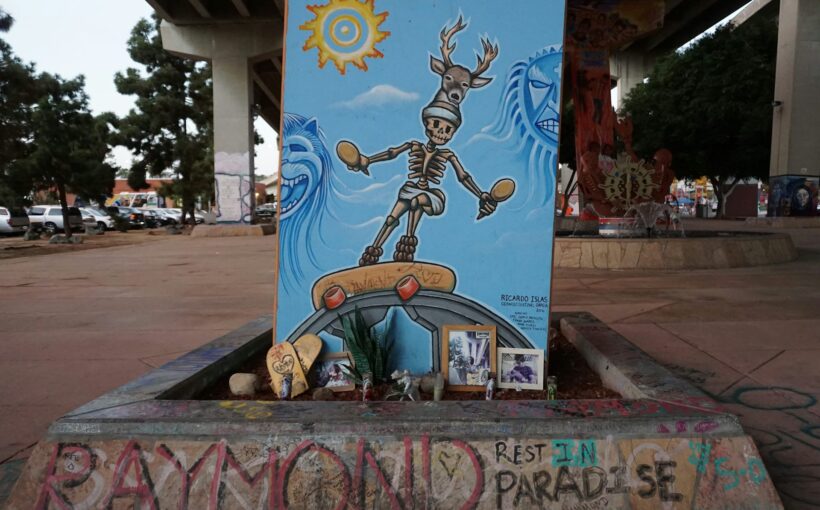
Urban wellbeing is increasingly tied to what urban planners term “green” and “blue” spaces: the parks and waterfronts that our towns and cities may include. Residents are also encouraged to leave the city altogether, to seek out the healthy calm of forest bathing, fell running or cold water swimming.
The potential of play within the urban environment, however, is often overlooked.
Skateboarders have long been invested in what I call “grey” space: the overlooked corners, edges and surfaces of the built environment. Skateboard magazines and videos routinely explore the social and architectural histories of sets of stairs and stone benches.
These spots, largely invisible to the general public, are richly symbolic. In seeing them as ramps and launchpads, skaters transform unremarkable bits of the city into ritual places of magic and wonder.
Recent research conducted with my colleague, Andrea Buchetti, shows that skateparks are sites of unstructured play and community, as well as remembrance and ritual. Otherwise banal and polluted locations are afforded layers of meaning and depth.

Skatepark memorialisation
The Chicano Park skatepark in San Diego is nestled below the imposing, blocky concrete columns of the on-ramps for the city’s Coronado bridge.
Built in 2015, the skatepark features four vibrant murals (by artists including Ricardo Islas) that draw on both the indigenous heritage of this ancient northern Mexican region and skateboard iconography. In memory of lost friends, local skateboarders build shrines at the foot of the paintings using broken skateboards, rocks, cacti and cut flowers.
The five-lane highway bridge above it stands 61 metres tall, allowing safe passage for ships bound to the nearby naval base. Completed in 1969, it links downtown San Diego with the smaller city of Coronado across San Diego Bay.
The space beneath the bridge has long been contested. When built, its route divided a longstanding Mexican American neighbourhood, Barrio Logan, that had already been disrupted by the construction of the Interstate 5 in 1963. Over 5,000 homes and businesses were destroyed in the process.
The state had promised the community a park by way of compensation. But on April 22 1970, Mario Solis, a local student, noticed bulldozers where the park should be, and found out the city was, in fact, constructing a highway patrol base there.
At Solis’s urging, more than 250 residents gathered with shovels and pickaxes to reclaim the land. They planted cacti and trees to create a communal park. After three months of protest, the city conceded to work with the community, and Chicano Park was officially established.

Local artist Salvador Torres was one of the people who lost their homes. In 1973, he galvanised the community into painting murals on the imposing chunks of concrete built in their stead. It was a form of creative resistance. The motifs referenced the cultural heritage of this ancient northern Mexican region, from Aztec symbolism to indigenous plants and beasts, and also Mexico’s colonial experience and revolutionary struggles.
The park is now a protected historic space and landmark. People gather there for annual celebrations on April 22.
Skateboarding as culture and community
Research has long shown the connection between sport and religion. Fans make pilgrimages to stadiums and worship athletes like gods.
Just as a football fan might worship at Wembley stadium in London, a specific neighbourhood curb might hold great significance because of a connection to a famous skater or a historic event. I have shown how skateboarding functions as a lifestyle religion. In the way they observe, perform and organise their communal activity, skateboarders derive spiritual expression and identity from both the physical act of skateboarding and the places in which it is conducted.
Some skateparks have dedicated plaques and permanent memorials designed into skateable features. When legendary San Francisco skateboarder and chief-editor of Thrasher magazine, Jake Phelps, died in 2019, a sculptor in Los Angeles made a concrete tombstone feature to install in the Lower Bob’s DIY skatepark in Oakland. He mixed some used dental floss Phelps had left behind into the concrete. “We don’t got his cremated body,” the artist told Thrasher, “but we got pretty much all the DNA we’re gonna need.”
London’s Skateboard Graveyard on one of the supports of Hungerford Bridge, on the South Bank, is another salient example. For years now, old boards have been thrown down from the Golden Jubilee footbridge in memory of Timothy Baxter, one of two skaters who were attacked and thrown into the river Thames in 1999.
Baxter died as a result and the juvenile attackers were convicted of manslaughter. Many of the skateboarders who take part in the ritual might not know that this is how it began, yet they persist in offering their broken boards to the site.

RIP epitaphs
In 2023, the skatepark in Sacramento’s Regency Park was renamed in honour of Tyre Nichols, a skateboarder who was beaten to death by police officers in Memphis, Tennessee.
Australian graphic design expert Dan Johnston has identified RIP epitaphs as one of the most common types of skateboarding-related graffiti. He cites messages he has noted on the steel ramps and concrete bumps of skater desinations in Singapore, Paris and south Australia – RIPs and Miss Us scrawled in white correction fluid, marker pen or spray paint.
Despite skateboarding’s recent ascent to Olympic status, for many skateboarders it is more a culture – or even a cult – than a sport. It brings diverse people together for unsanctioned play, recasting obstacles – an impassable buckled road in Wiltshire, say – as toys and tools.
In their provocative curves and surfaces, skateparks embody this creativity. They mimic the city beyond, showing how the built environment cannot just be conceived of as a framework for economic activity. Grey space – and grey times – can be transformed if communities, and the DIY cultures they give birth to, are allowed to flourish in the city.
![]()
Paul O’Connor currently is engaged with BA/Leverhulme Trust funded research into older skateboarders in the UK (SRG23\231468) from September 2023 -2025.



